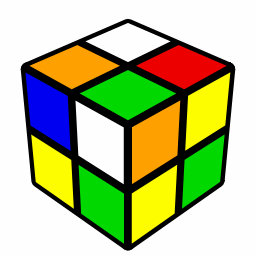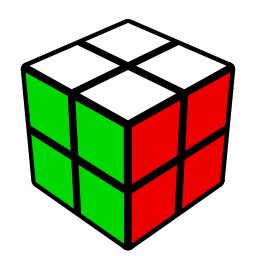2x2x2 Rubik's cube
 |
 |
The 2x2x2 Rubik's cube, also known as the "pocket cube", consists of 8 different-colored pieces. Each move is changing the positions of 4 pieces due to the inner cube mechanism. The aim of the puzzle is to achieve a state in which each cube face is consisted of exactly one color.
A 2x2x2 Rubik's cube (where 2 denotes the number of layers in the x,y,z coordinate system) can be in any of 3 674 160 different positions / configurations (i.e. 7!·36) - if one cubie on the cube is fixed, the other cubies may be permuted in 7! ways and the factor of 36 deals with the cubie orientations. As a result of group theory paragraph and consideration of that fixed cubie, remaining 6 cubies can have 3 ways of orientation because three different colors are painted / stickered on a cubie. It appears to be a relatively small number when compared to the 3x3x3 cube which has 43 252 003 274 489 856 000 different positions ([1] · [(12!/2)·(211)] · [(8!·37)]) if an axial cross is fixed. The fastest 2x2x2 cube speedcubers are able to find 1 of the 3 674 160 combinations (that one when the cube is solved) in less than 2 seconds.
A 2x2x2 Rubik's cube can be solved in 11 moves or less from any position (in 14 moves if considering X2 move as two moves, where X is either R, U, F, L, D or B - or their inverse moves - see a notation).
On this page you will find:
- 2x2x2 Rubik's cube - solving of one layer
- 2x2x2 Rubik's cube - orientation of opposite face
- 2x2x2 Rubik's cube - permutation of opposite face
- world record videos
2x2x2 Rubik's cube - solving of one layer
There are two terms for a 2x2x2 Rubik's cube that must be distinguished between. A layer and a face. It should be evident from the simulators.
| solved layer | solved white face |
Solve the first layer intuitively. Inspiration can be found in the 3x3x3 Rubik's cube tutorial, step 1 - solving of corners. The whole 2x2x2 cube is actually nothing more than 3x3x3 cube's corners.
2x2x2 Rubik's cube - orientation of opposite face
The opposite face is recognized as the one on which we don't find a color that occurs in a solved layer. That is the yellow face in case of a simulator. Orientation of pieces will be done with the help of commutators.
Orientation of 3 corners rotated clockwise / counter-clockwise can be solved in two phases. First we will correctly orient one corner (see moves 2 - 7 on next simulator), then we will apply an inverse procedure to the second corner (see moves 9 - 14). That way we'll get two corners rotated inversely from each other in phase 2, and we can already solve this situation (principally by the same manner).
2x2x2 Rubik's cube - permutation of opposite face
One out of three cases can appear on the puzzle at this moment. In the first one, the opposite layer will be solved, thus the whole cube will be solved as well. In the second one, two adjacent pieces will be permuted incorrectly in opposite layer - see left simulator below. In the third case, two diagonal pieces will be permuted incorrectly in opposite layer - see right simulator below. The second and third case is collectively called a parity problem. After solving it in the first move (see the theory in linked article), we will solve the cube using commutators (in which 3 corners will be cycled).
I'm not sure why - perhaps out of nostalgia - I'm keeping here a page with other solving methods for a 2x2x2 Rubik's cube. Since there is no equivalent of that text in Czech yet, I will at least link to it from here. It was last updated in 2010 (next update is not planned) so the page is slowly (read: quickly) becoming to be outdated. Here it is.
World record videos
As a football has FIFA and athletics has IAAF, also the 2x2x2 Rubik's cube has some sort of board that organizes the competitions worldwide. It is WCA - World Cube Association. Thus it can be officially competed in a solving of the 2x2x2 Rubik's cube. It is competed in two formats: single fastest solve of the puzzle and average solve. As an average, five consecutive times of one round are taken, the best and the worst time is not considered and from the remaining three times an arithmetic mean is calculated.
| event: 2x2x2 single solve | ||
| name: Maciej Czapiewski (Poland) | ||
| result: 0.49 s | ||
| scramble: U' R F R U R F' U' R2 U' F | ||
| solution: x y' U' R U R' | ||
| cube brand: DaYan | ||
| solving method: God's algorithm | ||
| personal opinion on used method: see below | ||
| competition: Grudziądz Open; 19-20. 3. 2016; Poland |
| event: 2x2x2 average solve | ||
| name: Martin Vӕdele Egdal (Denmark) | ||
| result: 1.21 s | ||
| scrambles: available upon request | ||
| solutions: available upon request | ||
| cube brand: ChuWen M | ||
| solving method: EG | ||
| personal opinion on used method: see below | ||
| competition: Kjeller Open; 20-21. 10. 2018; Norway |
If you find a so-called speedcubing interesting, check out an article about where to buy a Rubik's cube, what cube is the best and how to solve it faster.
Personal opinion on methods used in the world records
2x2x2 Rubik's cube
Optimal solution (God's algorithm by another name) has been used in case of the world record for single solve. It means that a scrambled cube has been solved by the fewest needed moves. I don't think it will be easy to break this record, considering that picking the cube up from the mat and stopping the timer at the end of a solve takes approximately 0.3 seconds, at least. That leaves less than 0.2 seconds for a solve itself. Clearly, the cube cannot be solved that fast (no matter what method is used) in the long term.
Hence an average time is the indicator of competitor's quality in case of a solution of "simple" puzzle. If you can imagine a placement of stickers on the cube after a few moves, the EG method is very effective. One face of a cube can be always solved in 5 or less moves. Martin Vӕdele Egdal, as an experienced cuber, can do this, and what's more, he is sometimes able to determine stickers placement after these moves. Therefore, he knows the entire cube solution even before he starts to solve the puzzle because after these at most 5 moves, the second and final step of a method follows.
The page was graphically improved by Michael Feather and Conrad Rider.